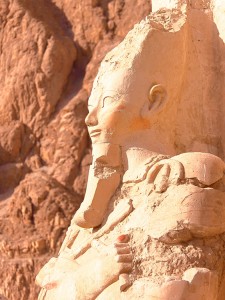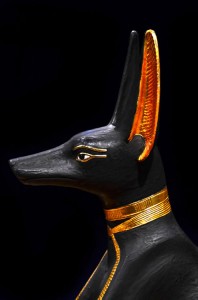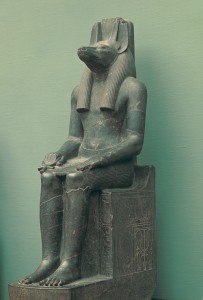Mythic Monday: Osiris of the Underworld
Monday, September 11th, 2017September 11, 2017
The ancient Egyptians told countless stories about their gods and goddesses, but one, called the Osiris myth, was the most popular of them all. In this story, the Earth god Geb retired to heaven and appointed his son Osiris, god of agriculture and fertility, as the new king of Egypt. Osiris took the fertility goddess Isis as his queen. Seth, god of chaos and the desert, grew jealous of Osiris’ new position of power and killed him. Seth chopped up Osiris’ body and stuffed the pieces into a box, which he sent floating down the Nile River. Isis was horrified and could not accept her husband’s death. With the help of other gods and goddesses, she found the box containing Osiris’ body and put the pieces back together, restoring him to life. Osiris then became god of the afterlife, ruling over the underworld.

A statue depicting Osiris stands at Hatshepsut Temple in Egypt’s Valley of the Kings. Credit: © Christophe Cappelli, Shutterstock
Ancient Egyptians believed that if Osiris could triumph over death, so could human beings. Early rulers were referred to as “Osiris” after they died and were considered to be immortal, carrying on their lives in the underworld. By around 2000 B.C., common people believed that they too could continue living in the afterlife. In order to achieve this, they had to perform mortuary rituals in preparation for a trial after death. Osiris oversaw this trial, in which the heart of the deceased was weighed against an ostrich feather, a symbol of truth and justice. The bearer of a light heart was allowed to become immortal. Mortuary rituals are described in a collection of ancient texts known as The Book of the Dead.
In art, Osiris is generally shown as a bearded human mummy with green or black flesh. In his hands he holds a shepherd’s crook and a whip, symbols that were often associated with pharaohs and other Egyptian state leaders. On his head, Osiris wears a conical white crown with ostrich feathers.
In addition to being ruler of the underworld, Osiris continued his role as the god of agriculture and fertility. Ancient Egyptians believed that the powerful Osiris had a cosmic influence over the cycles of the moon, allowing him to control the tides. Seasonal flooding of the Nile, which played a crucial role in Egypt’s yearly harvests, was thus attributed to Osiris. Farmers, common folk, and royalty all recognized the god’s importance, and the cult of Osiris became widespread, lasting many centuries.




